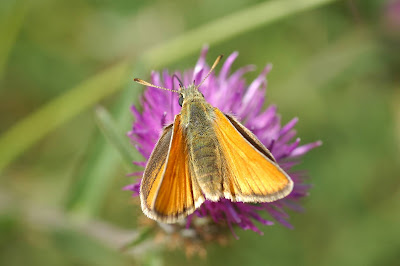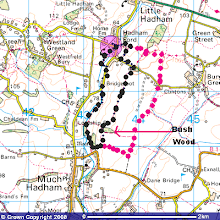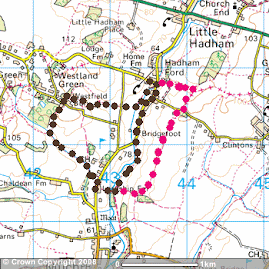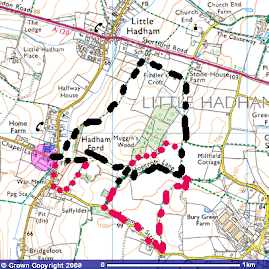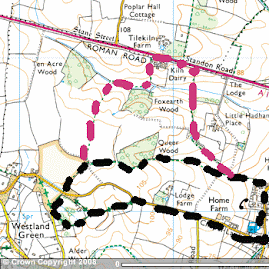Happy to see any photos for id purposes and to hear records of White letter hairstreak, Purple Hairstreak and Painted Lady.
Whites
Large white
Found just about everywhere. Note yellow/cream underwing and extensive black, jet black when fresh, around wing tips. Male has small black mark on hindwing whilst females have 2 large black dots on forewing.
Small white
Again, everywhere. Usually smaller than large white, much less black on wing tips, frequently grey and worn and just one dot on upper forewing. Often this and above species are found together so a little looking helps distinguish them.
Green Veined white
Again, a common species found in many habitats. Look for the dark veins when the wings are closed as shown above. Similar size to average Small white. Shows two indistinct spots on upper forewing.
Marbled white
Unmistakable insect. Slow flapping flight often alighting on knapweeds, thistles and other flowerheads. Usually only found in grassland areas.
Orange tip.
Orange tip will be on the wing soon. One of their larval foodplants is Jack in the hedge so often found wherever this plant is growing, such as edges of woods and grass verges on country lanes. Note underwing pattern shown here to id female which looks similar to other whites. Male unmistakable.
Blues
Common Blue
Males unmistakable, a darker blue than similar Holly blue but the underwing pattern is completely different. Females are brown with blue hairs on thorax and abdomen and very similar to Brown Argus, see below. Gardens and open ground where there are an abundance of flowers to nectar upon. Territorial chasing off of other blues but usually returns to same area to nectar.
Brown Argus.
As stated, similar to female Common blue. Need to see the underwing where there is more orange on the border and the black dots have larger white around them. Tricky. Also, the black streak on the upper forewing is usually more prominent on Brown argus than female Common blue. Similar habitats to Common blue, rarely seen in gardens whereas Common blue may well be present.
Holly Blue
Invariably a lighter blue than Common but easy to identify once the wings are closed as there will just be black dots and streaks. Found in gardens, normally not far from ivy or holly
Browns.
Meadow Brown
The most common butterfly around here. Grasslands, and woodlands and larger gardens will all have these insects. Variable markings with colours ranging from orange to brown. Diagnostic is the single white dot in the eye ring. Found on male and female. If you find one, there will be many other present.
Gatekeeper
Invariably perceptively smaller than Meadow brown and usually shows darker oranges and browns. 2 white dots in the eye ring on upper and lower forewings nails the identification. Loves bramble flowers and can be quite approachable. Hedgerows, floral areas of woodland best for this smart butterfly.
Ringlet
Much more of a chocolate brown, this is a butterfly of woodland rides and woodland borders where there are grasses. Eyerings on underside of wings very noticeable, less so on upper wing. Associates with Gatekeepers and Meadow browns so possible to get an identification on all three in the same habitat
Speckled Wood
A common butterfly of woodlands and woodland rides. Usually rest with wings open making identification easy. Look for the pale yellow spots that help camouflage it in dappled woodland sunlight.
Small Heath
Underwings similar to Meadow brown but look for grey hairy thorax and head and much smaller size. A butterfly that likes grasslands and often roosts almost on its side. Lands regularly and can be approachable
Skippers
Large skipper
Considerably larger than the two other species mentioned below. Has very prominent black stripes on the upperwing and shows lighter, rectangular blotches on underwing as shown above. Often rests and feeds with wings half closed. Wider border around wings than other 2 sp.
Small skipper
Moth-like butterfly. Narrow darker border around wings and usually plain orange wing colouring. Diagnostic feature is that there will be orange as well as black on the clubs of the antennae as shown here.
Essex Skipper
Very similar to Small skipper, sometimes showing a few black streaks on wings but just need to check colour of clubs on antennae. All black makes it Essex skipper. All 3 skipper species will be present in grasslands with plants such as Knapweeds, Wild carrot, thistles etc. Again, find one and there will be many others, often all 3 species together.
Oranges
Comma
Ragged look to the wings is a giveaway for Comma. No other butterfly here shows this feature. If wings are closed a brown patterning is apparent with a small white "comma" mark fairly central. Gardens on buddleia, hedgerows etc.
Silver Washed Fritillary
A distinctive butterfly, that often glides on large, flat wings. Pattern on upperwing separates this from any other species. Much larger than the Comma. Will be found in floral woodland rides and on the borders of well established woodland. Uses old oaks to lay its eggs so the older the wood the more likely this will be present.
Small Copper
A small butterfly and basically unmistakable. Seems to be increasing in number in East Herts. Often seen resting on warm, dry soil and will fly forward when disturbed. With a little stealth it is possible to get close enough for a decent phone photo. Note dark hindwings. Similar size to the blues.
Hairstreaks
White letter hairstreak
Almost exclusively a woodland species and then, only where elms are present. In July, find an elm and this butterfly will be present. Side Hill Wood near Much Hadham good for these and a resident population in Stocking Wood as well, near Bury Green. Look for the distinctive white line when wings are closed along with the orange border and, when fresh, the small tail as shown here. Be pleased to hear of all sightings locally of this species.
Purple hairstreak
A grey/purple butterfly of oak woods. Usually spends its time in the canopy but will come down to nectar, often in the afternoon and after a morning rain shower. Single eye dot shows on the underwing. There are plenty of these butterflies about but due to their residence in the canopy are usually under recorded. Be pleased to hear of records of these locally.
Assorted others.
Red admiral
Familiar garden butterfly that feeds upon buddleia but also found along hedgerows. The orange band across the upperwings distinguishes this common species.
Peacock
Unmistakable butterfly with its blue and red eye spots. Gardens, woodland borders and floral grasslands. Can look jet black when wings are closed but in fact this is a very intricate pattern of dark browns and blacks. as shown above.
Small tortoiseshell
Another common garden butterfly also found in fields and hedgerows. A very much orange butterfly with super blue edging when fresh.
Brimstone
Unmistakable. Leaf shaped wings. Male yellow, female green. Flies in spring and then next generation emerge in July/August. Always close to good stands of flowers.
Painted Lady
Migratory butterfly and very few around this year, but can turn up in huge numbers. Can be confused with Red admiral but upon closer inspection there is no orange band, less black and main colour is a salmon pinky orange. Be pleased to hear of any sightings. Often found in early autumn on buddleia bushes but also found in floral grasslands.
Other possibility
6 spot Burnet moth
Can only be confused with the similar Narrow bordered 5 spot burnet moth, but a quick check on the spots solves the id issue. Found in grasslands where there is bird's foot trefoil, so often found with Marbled whites. Loves feeding on knapweed
Good local sites
The following are some of the best sites around Bishop's Stortford for butterflies.
Hatfield Forest
Probably the premier site with just about all of the species shown here being present and in good numbers. At the moment, car park space has to be book in advance.
Wall Wood
Other side of the road from Hatfield Forest in Woodside Green. Good selection of woodland species along the paths here.
Southern Country Park
Several entrances, Thorley Lane and St Michaels Mead. Good selection of species here. Head for the unmown, dog free area in the middle of the park where there will be a good variety. Plenty of Marbled whites at present but they will be finished soon.
Stocking Wood
Half hour walk from Tescos or 15 minutes from Bury Green. Along the footpath, about halfway into the wood from either side is an overgrown ride full of knapweed and lady's bed straw along with bramble. Good variety of expected species here.
M11 footpath north to Burton End
Open and untouched pasture here holds many species, 17 alone on Monday 20th July. Park in Birchanger village and take footpath from near the pub over the M11 and turn left. Path runs parallel to motorway all the way to Forest Hall/Burton End. Grassland species a plenty.
Birchanger to old A120 and Flitch Way
Same start as last route but turn right after the bridge, under a tunnel, over another footbridge brings you to untouched pastures.
Stansted Airport Lagoons
Park near Green Man pub near the turn to Hatfield Forest. Pick up footpath next to last building on left (Primo tiles) and cross the footbridge up to the lagoons. Good stand of bird's foot trefoil and knapweed in the far right hand corner, through a mesh gate but butterflies all over here.
Westland Green
Turn left into Chapel Lane, Little Hadham just before the Nags Head pub when coming from Much Hadham (due to road closures at present). Go past the travellers' site, through a spinney and the green is on the left. Small muddy layby here. Open grassland, really good for Marbled white.
Tips
Do take binoculars with you for butterfly watching so if they fly up into the trees you can still id them. If photographing them make sure you don't cast your shadow over them. They'll fly off. Check where the sun is and approach accordingly, bearing in mind many butterflies open their wings in full sun so frequently your approach will be wrong for photos so track around the side. A zoom lens certainly helps.
Check Butterfly Conservations Big Butterfly count. Google Big Butterfly count and the app may already be there to download but the survey will be later in the year. Download the app and off you go. So easy. It'll ask a few details and will even place you on the map so no need for map references. Then has a list of common species mentioned here. Click on correct number for each species and submit. Only keep a count of how many you saw for each species in 15 minutes. Very straightforward.

























